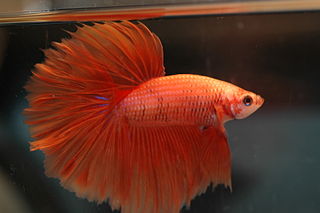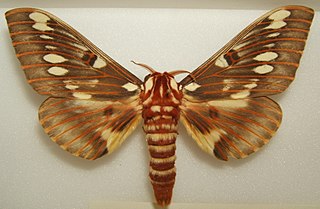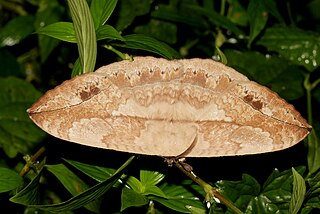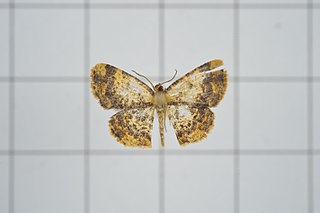
The Siamese fighting fish, also known as the betta, is a freshwater fish native to Thailand and present in neighboring Cambodia, Laos, Malaysia, and Vietnam. While colloquially known and marketed in the global aquarium trade as the "betta", it is one of 73 species in the genus Betta. Siamese fighting fish are among the most popular and widely available aquarium fish in the world, due to their varied and vibrant colour, diverse morphology, and relatively low maintenance.
Banksia undata var. splendens is a shrub endemic to Western Australia.

Paraona is a genus of moths in the family Erebidae. The genus was described by Moore in 1878. It is treated as a synonym of Macrobrochis by some sources.

Lacanobia splendens, the splendid brocade, is a moth of the superfamily Noctuoidea. The species was first described by Jacob Hübner in 1808. It is found in temperate Europe and Asia up to the Pacific coast and Japan.

Citheronia splendens, the splendid royal moth, is a moth of the family Saturniidae. It is found from southern Arizona south into central and south-eastern Mexico. The species was first described by Herbert Druce in 1886.

Eupanacra is a genus of moths in the family Sphingidae.

Eupanacra splendens is a moth of the family Sphingidae.
Diospage splendens, the Burnet tiger, is a moth of the subfamily Arctiinae. The species was first described by Herbert Druce in 1895. It is found in Ecuador, Peru and Bolivia.
Paraona micans is a moth of the family Erebidae. It is found on Java.
Loxophlebia splendens is a moth of the subfamily Arctiinae. It was described by Heinrich Benno Möschler in 1872. It is found in French Guiana.
Lycomorpha splendens is a moth of the family Erebidae. It was described by William Barnes and James Halliday McDunnough in 1912. It is found in North America, including Arizona, California, Nevada, New Mexico, Texas and Utah.
Paraona cocciniceps is a moth of the family Erebidae. It was described by Paul Mabille in 1884. It is found on Madagascar.
Macrobrochis nigra is a moth of the subfamily Arctiinae. It was described by Franz Daniel in 1952. It is found in Shaanxi, China.
Paraona interjecta is a moth of the family Erebidae. It was described by Strand in 1912. It is found in Lesotho, South Africa and Zimbabwe.
Pseudocharis splendens is a moth in the subfamily Arctiinae. It was described by Herbert Druce in 1888. It is found in the Bahamas.
Pseudohemihyalea splendens is a moth in the family Erebidae. It was described by William Barnes and James Halliday McDunnough in 1910. It is found from south-eastern Arizona in the US to Mexico.
The Lithosiina are a subtribe of lichen moths in the family Erebidae. The taxon was erected by Gustaf Johan Billberg in 1820.
Eurrhyparodes splendens is a moth in the family Crambidae. It was described by Herbert Druce in 1895. It is found in the US from Arizona and Texas through the Mexican states of Xalapa, Veracruz, Morelos, Guerrero and Yucatán to Guatemala and Costa Rica.

Eupterote is a genus of moths in the family Eupterotidae. It was first described by Jacob Hübner in 1820.

Ninodes splendens is a moth in the family Geometridae described by Arthur Gardiner Butler in 1878. It is found in Japan.







